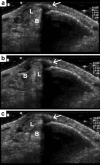Economics of Musculoskeletal Ultrasound
- PMID: 27398265
- PMCID: PMC4914528
- DOI: 10.1007/s40134-016-0169-5
Economics of Musculoskeletal Ultrasound
Abstract
Purpose of review: Healthcare costs have exploded in the past 30 years and they are a major concern for governments worldwide. Care management of musculoskeletal disorders and advanced imaging account for a large part of this socioeconomic burden.
Recent findings: Musculoskeletal ultrasound is now performed primarily by nonradiologists. Both musculoskeletal ultrasound and MRI total utilization rates continue to increase. Despite the existence of evidence-based diagnostic recommendations and the potential cost-savings of using musculoskeletal ultrasound instead of MRI in certain clinical situations, ensuring appropriate use of imaging among health professionals remains difficult for various reasons.
Summary: In the context of healthcare budgets restraints, use of imaging must be shown scientifically, to improve patient outcomes and be cost-effective. Current evidence recommends musculoskeletal ultrasound as the primary imaging modality in the investigation of rotator cuff disease. Policies aiming at ensuring the application of imaging guidelines among physicians are needed.
Keywords: Economics; Healthcare costs; Imaging; Magnetic resonance imaging; Musculoskeletal system; Ultrasonography.
Figures

Similar articles
-
Musculoskeletal imaging: medicare use, costs, and potential for cost substitution.J Am Coll Radiol. 2008 Mar;5(3):182-8. doi: 10.1016/j.jacr.2007.07.016. J Am Coll Radiol. 2008. PMID: 18312965
-
MSK ultrasound imaging-assisted clinical examination.Ultrasound. 2024 Sep 20:1742271X241280911. doi: 10.1177/1742271X241280911. Online ahead of print. Ultrasound. 2024. PMID: 39555161 Free PMC article.
-
Physician Training Ultrasound and Accuracy of Diagnosis in Rotator Cuff Tears.Bull Hosp Jt Dis (2013). 2016 Sep;74(3):207-11. Bull Hosp Jt Dis (2013). 2016. PMID: 27620544
-
Musculoskeletal ultrasound: focused impact on MRI.AJR Am J Roentgenol. 2009 Sep;193(3):619-27. doi: 10.2214/AJR.09.2841. AJR Am J Roentgenol. 2009. PMID: 19696273 Review.
-
Current imaging of the rotator cuff.Sports Med Arthrosc Rev. 2011 Sep;19(3):300-9. doi: 10.1097/JSA.0b013e3182189468. Sports Med Arthrosc Rev. 2011. PMID: 21822112 Review.
Cited by
-
Detecting Rotator Cuff Tears: A Network Meta-analysis of 144 Diagnostic Studies.Orthop J Sports Med. 2020 Feb 5;8(2):2325967119900356. doi: 10.1177/2325967119900356. eCollection 2020 Feb. Orthop J Sports Med. 2020. PMID: 32076627 Free PMC article. Review.
-
MSK Ultrasound - An IJSPT Perspective.Int J Sports Phys Ther. 2023 Feb 2;18(1):1-10. doi: 10.26603/001c.68184. eCollection 2023. Int J Sports Phys Ther. 2023. PMID: 36793557 Free PMC article.
-
Mapping theme trends and recognizing research hot spots in the use of ultrasound in orthopaedics: a bibliometric analysis of global research.Am J Transl Res. 2021 Aug 15;13(8):9892-9911. eCollection 2021. Am J Transl Res. 2021. PMID: 34540126 Free PMC article.
-
The impact of a novel musculoskeletal consult service in an inpatient rehabilitation facility: A descriptive analysis.PM R. 2024 Jul;16(7):707-714. doi: 10.1002/pmrj.13118. Epub 2024 Feb 14. PM R. 2024. PMID: 38148275 Free PMC article.
-
Prospective Analysis of the Effectiveness of Targeted Botulinum Toxin Type A Injection Using an Ultrasound-Guided Single-Point Injection Technique for Lower Face Contouring.J Clin Med. 2024 Sep 9;13(17):5337. doi: 10.3390/jcm13175337. J Clin Med. 2024. PMID: 39274549 Free PMC article.
References
Publication types
LinkOut - more resources
Full Text Sources
Other Literature Sources
Research Materials
Miscellaneous
